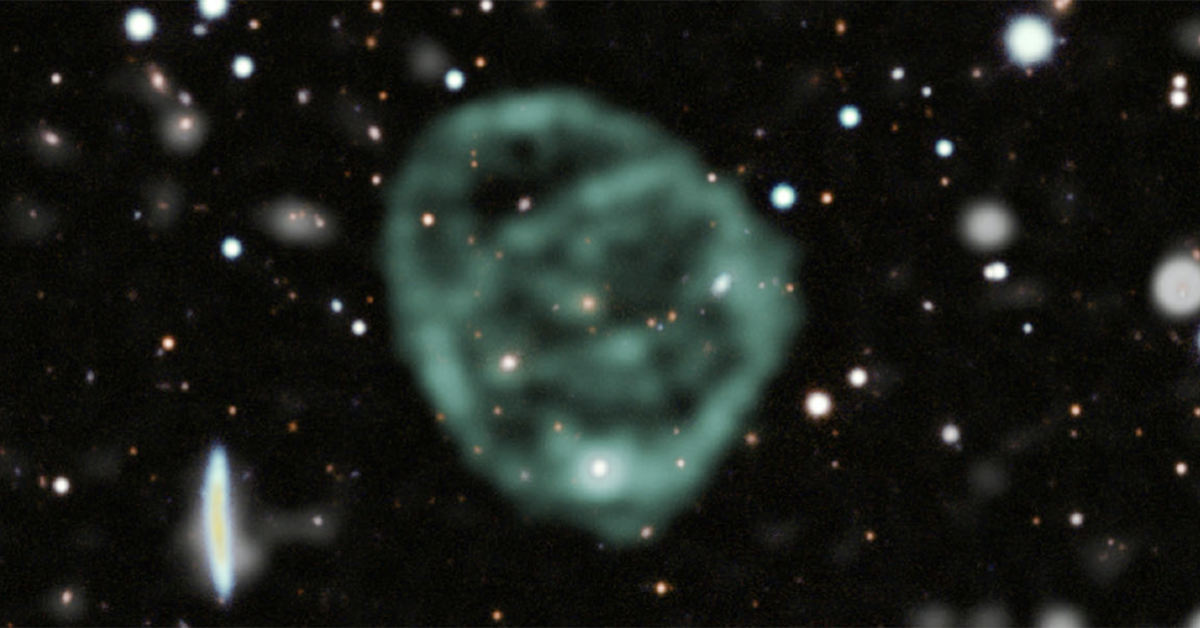Astronomers ask questions like, “What is that?” not very often. Cosmological phenomena such as stars, planets, black holes, and galaxies are the most commonly observed and understood.
 Odd radio circles, like ORC 1 pictured above, are large enough to contain galaxies in their centers and reach hundreds of thousands of light years across. Image Credit: Jayanne English/University of Manitoba
Odd radio circles, like ORC 1 pictured above, are large enough to contain galaxies in their centers and reach hundreds of thousands of light years across. Image Credit: Jayanne English/University of Manitoba
However, something unprecedented was detected in 2019 by the recently finished Australian Square Kilometer Array Pathfinder (ASKAP) telescope: radio wave circles so big that the waves contained entire galaxies in their centers.
The question of why the circles were there was as much of an interest to the astrophysics community as what these circles were. Now, a group led by Professor of Astronomy and Astrophysics Alison Coil of the University of California, San Diego, may have discovered the solution: the circles are shells created by outflowing galactic winds, maybe from massive supernovae explosions. The research was published in Nature.
These extremely quick outflowing winds can be produced by massive “starburst” galaxies, which Coil and her colleagues have been researching. Star formation is incredibly common in starburst galaxies.
Gas from the star and its surroundings is released back into interstellar space when stars explode and die. The force of several stars exploding close to one another at the same time can drive gas out of the galaxy and into outflowing winds, which have a speed of up to 2,000 kilometers per second.
These galaxies are really interesting. They occur when two big galaxies collide. The merger pushes all the gas into a very small region, which causes an intense burst of star formation. Massive stars burn out quickly and when they die, they expel their gas as outflowing winds.
Alison L. Coil, Chair and Professor, Department of Astronomy and Astrophysics, University of California
Massive, Rare, and of Unknown Origin
In 2019, odd radio circles (ORCs) were detected for the first time, thanks to technological advancements that made it possible for ASKAP to scan a large area of the sky at very faint limits. The Milky Way galaxy is roughly 30 kpc across, so the ORCs were massive, measuring hundreds of kpc across, where a kpc is equivalent to 3,260 light years.
Black hole mergers and planetary nebulae were two of the theories put forth to explain the origin of ORCs, but radio data was unable to distinguish between the two. Enticed, Coil and colleagues speculated that the radio rings might represent an evolution from the later phases of the starburst galaxies the scientists had been observing.
The scientists started investigating ORC 4, which is the first known ORC that can be seen from the Northern Hemisphere.
Until then, there had been no optical data and ORC observations had only been made through the radio emissions. When Coil’s group examined ORC 4 with an integral field spectrograph at the W.M. Keck Observatory in Maunakea, Hawaii, the group discovered an enormous amount of compressed, heated, and highly luminous gas - much more than is seen in the typical galaxy.
The group started working as detectives, but there were more questions than answers. The group calculated the age of the stars within the ORC 4 galaxy to be about 6 billion years old using optical and infrared imaging data.
Coil states, “There was a burst of star formation in this galaxy, but it ended roughly a billion years ago.”
A co-author of the paper, Cassandra Lochhaas is a postdoctoral fellow at the Harvard & Smithsonian Center for Astrophysics who specializes in the theoretical side of galactic winds. Lochhaas used a suite of numerical computer simulations to mimic the bulk of shocked, cool gas in the central galaxy as well as the size and characteristics of the large-scale radio ring.
According to Lochhaas models, the outflowing galactic winds would continue to blow for 200 million years before ceasing. When the wind ceased, cooler gas fell back onto the galaxy from a reverse shock, while forward-moving shock continued to push high-temperature gas out of the galaxy and form a radio ring. The simulation ran for 750 million years, roughly equivalent to ORC 4’s estimated stellar age of one billion years.
To make this work you need a high-mass outflow rate, meaning it’s ejecting a lot of material very quickly. And the surrounding gas just outside the galaxy has to be low density, otherwise the shock stalls. These are the two key factors. It turns out the galaxies we’ve been studying have these high-mass outflow rates. They’re rare, but they do exist. I really do think this points to ORCs originating from some kind of outflowing galactic winds.
Alison L. Coil, Chair and Professor, Department of Astronomy and Astrophysics, University of California
Not only can outflowing winds help astronomers understand ORCs, but ORCs can also help astronomers understand outflowing winds. Coil concludes, “ORCs provide a way for us to ‘see’ the winds through radio data and spectroscopy. This can help us determine how common these extreme outflowing galactic winds are and what the wind life cycle is. They can also help us learn more about galactic evolution: do all massive galaxies go through an ORC phase? Do spiral galaxies turn elliptical when they are no longer forming stars? I think there is a lot we can learn about ORCs and learn from ORCs.”
Computer Simulation of Outflowing Galactic Wind
This simulation of an outflowing galactic wind provides a possible explanation for the origin of odd radio circles. Video Credit: Cassandra Lochhaas/Space Telescope Science Institute.
Journal Reference:
Coil, L. A., et al. (2024). Ionized gas extends over 40 kpc in an odd radio circle host galaxy. Nature. doi/s41586-023-06752-8